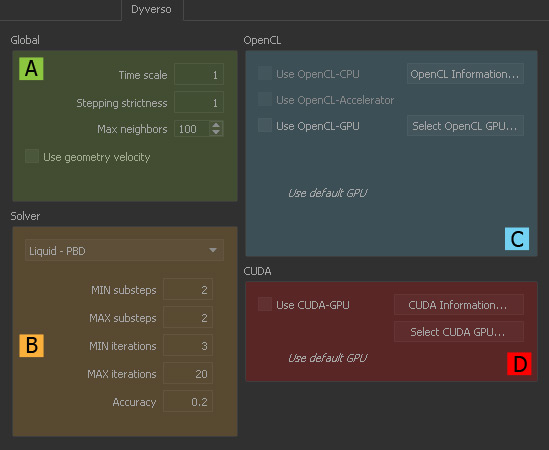RealFlow's scene-related simulation options are located here:
To change the parameters of this tab on a global level use the → "Preferences - Simulation: Dyverso" dialogue.
NEW SCREENSHOT (new solvers?)
Jump to
Table of Contents maxLevel 3
Global (A)
Time scale
Values smaller than 1.0 will decelerate the fluid; settings greater than 1.0 have an acceleration effect. “Time scale” works as a factor: 2.0 means that the fluid will be two times faster.
...
RealFlow calculates how fast the fluid will move within a → substepa substep:
- With a value of 1.0, the fluid will not move more than 1 grid cell in the current time step.
- With values smaller than 1.0, the fluid can cover a longer distance within a single step – the solver is less strict.
...
When enabled RealFlow will adjust the simulation's → substeps to substeps to get a correct fluid-object interaction behaviour:
Imagine an object falling into a container with → calm water.
Here, RealFlow uses very large substeps to speed up the simulation.
Due to these large steps the interaction between the object and the fluid is delayed.
With “Use Geometry Velocity” the interaction will happen in time again.
...
Specify the minimum number of simulation steps for → Dyverso PBD fluids:
- Higher values increase simulation time and can lead to instabilities with PBD fluids. We recommend moderate increases of just a few substeps.
- For a fixed number of substeps use equal values for “MIN substeps” and “MAX substeps”.
- The default value normally provides the best ratio between speed and accuracy.
...
Specify the maximum number of simulation steps for → Dyverso PBD fluids:
- Higher values increase simulation time and can lead to instabilities with PDB fluids. Try using values around the default setting.
- For a fixed number of substeps use equal values for “MIN substeps” and “MAX substeps”.
- The default value normally provides the best ratio between speed and accuracy.
...
Specify the minimum number of simulation cycles for → Dyverso PBD fluids:
- Higher values increase simulation time, but also avoid instabilities.
- For a fixed number of iterations use equal values for “MIN iterations” and “MAX iterations”.
...
Specify the maximum number of simulation cycles for → Dyverso PDB fluids:
- Higher values increase simulation time, but also avoid instabilities.
- For a fixed number of iterations use equal values for “MIN iterations” and “MAX iterations”.
...
Specify the minimum number of simulation steps for → Dyverso SPH fluid type:
- Higher values increase simulation time, but also avoid instabilities.
- For a fixed number of substeps use equal values for “MIN substeps” and “MAX substeps”.
...
Specify the maximum number of simulation steps for → Dyverso SPH for Dyverso SPH fluid type:
- Higher values increase simulation time, but also avoid instabilities.
- For a fixed number of substeps use equal values for “MIN substeps” and “MAX substeps”.
...
Due to the almost infinite number of hardware combinations we cannot guarantee that RealFlow's OpenCL features are available for any computer or graphic device. Please read the → FAQ - Dyverso & GPUs→ "GPU" chapter if you encounter performance issues.
...
Got more than one GPU in your computer? Choose here which board you want to use with your Dyverso simulation.
CUDA (E)
Please read the → FAQ - Dyverso & GPUs→ "GPU" chapter if you encounter performance issues.
Use OpenCL-CUDA
You can activate this option if your graphics card has CUDA capability, otherwise it is greyed out.
CUDA Information...
Open a comprehensive summary about your GPU's CUDA features and capabilities.
...
